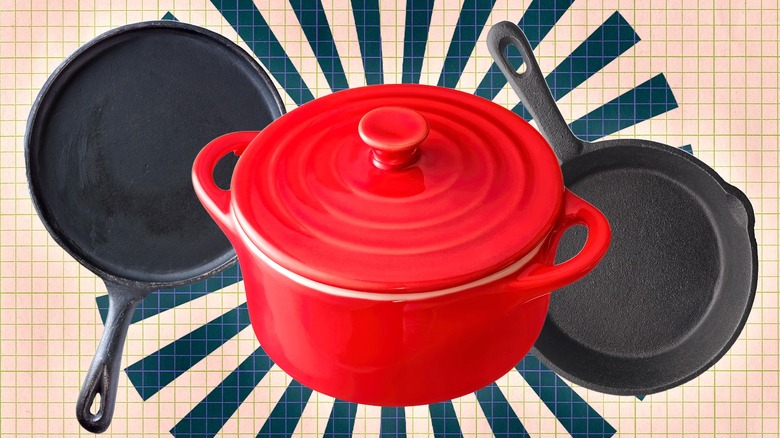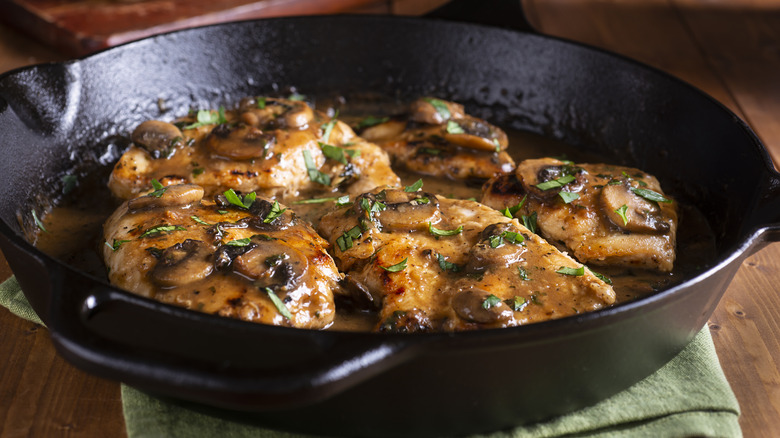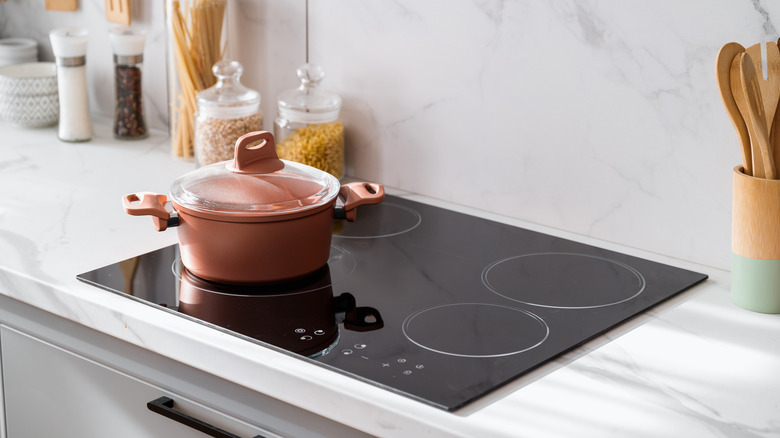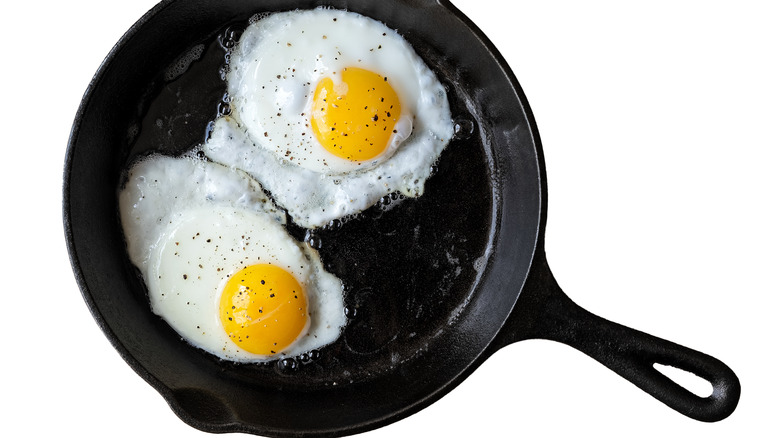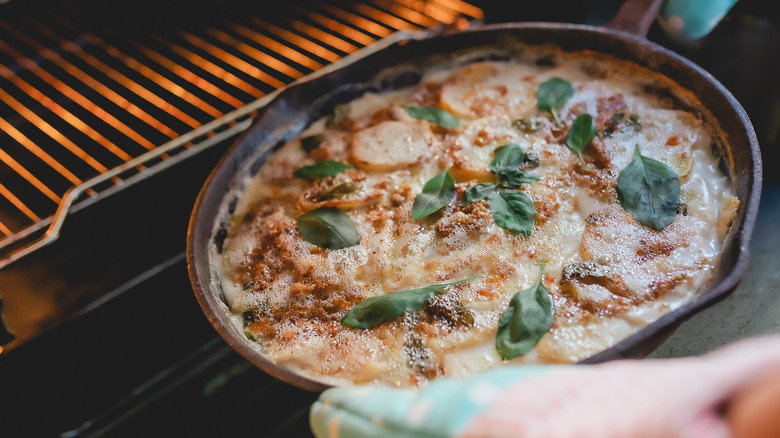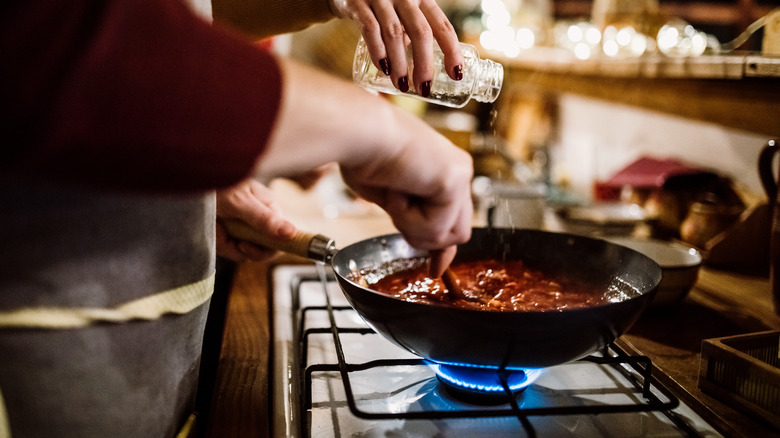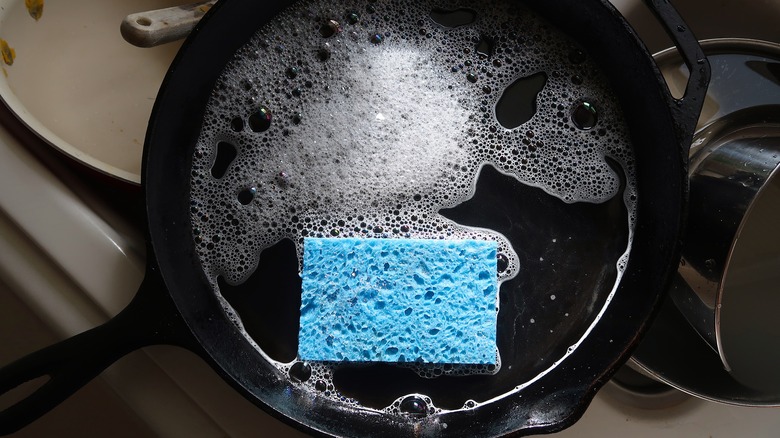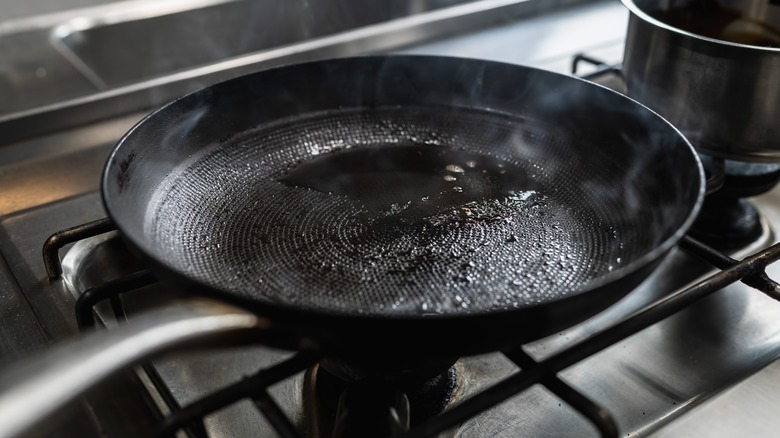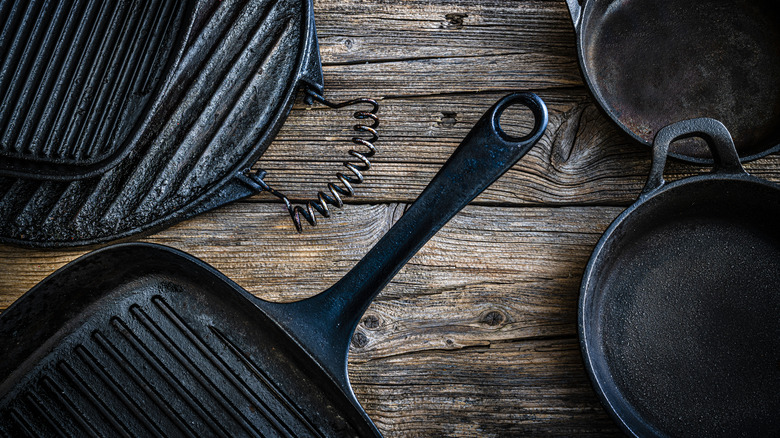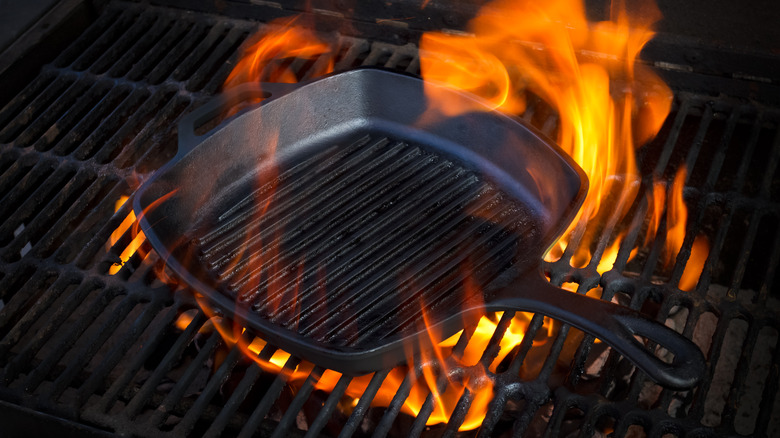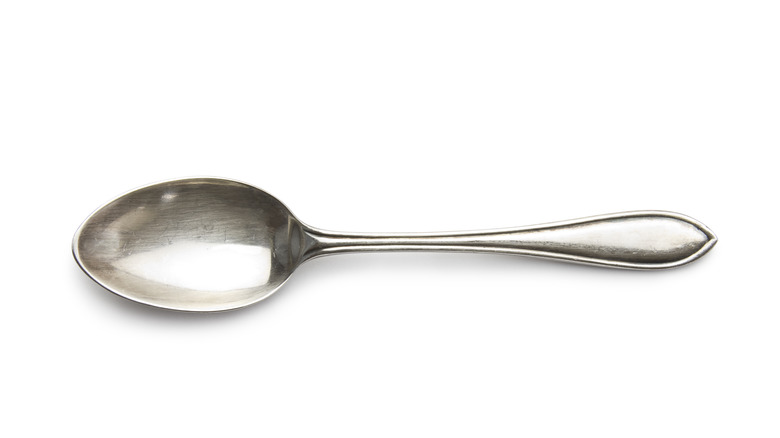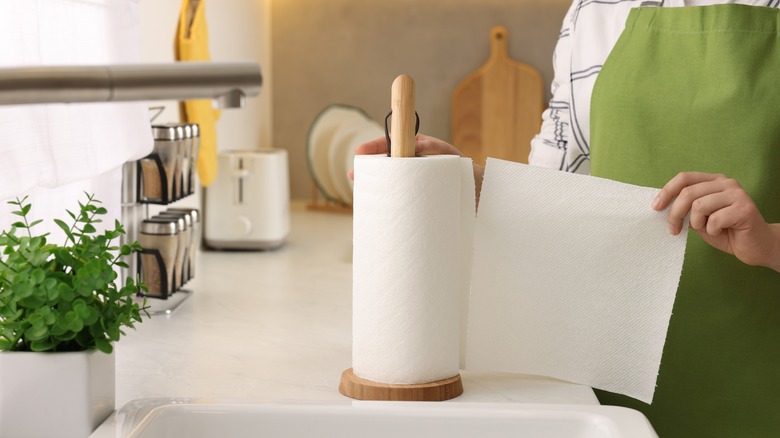13 Facts You Should Know About Cast Iron Cookware
Before there was Teflon and stainless steel, there was cast iron cookware, a staple of kitchens worldwide for centuries. Typically made from an iron-carbon alloy, cast iron pans excel at maintaining and evenly distributing heat, all while providing convenient non-stick properties. Not only that, but you can use cast iron cookware on stovetops, in the oven, and even on the grill without fear of damaging it or harming the integrity of the food you're cooking.
At the same time, you should not take your cast iron cookware for granted. It may be long lasting and almost indestructible, but just like every other kitchen tool, it needs some care every once in a while, and you can get out of it only what you put in. In other words, if you don't season your cast iron pan — meaning coating the cookware with a thin layer of oil after using it — you may end up with a tool that doesn't deliver on its promises. But there are few other facts about cast iron cookware you should know before you go merrily on your way. In order to optimize its performance and keep your pan for generations to come, it may be useful to be aware of what you're getting yourself into. So let's take a look at some important facts that may interest you on the subject.
Most cast iron pans come pre-seasoned
You may have heard people talking about the seasoning process for cast iron pans. This involves washing your pan after use, applying a thin layer of oil to its surface, and heating the pan up again to create a natural non-stick cooking vessel. You may also have heard that these steps need to be repeated every time you use your pan, and perhaps even felt intimidated by the prospect.
But while it may be true that you have to apply oil to your pan after each use, you don't always have to worry about this before your first-time use. That's because most cast iron pans come pre-seasoned so they can be used as soon as you bring them home. If they weren't, you would indeed have to thoroughly season them yourself before cooking with them. That said, know that seasoning them at home after each use makes them even more non-stick, so unlike Teflon, which may lose its non-stick properties over time, cast iron actually improves on this level over the years. If for some reason the seasoning gets stripped, you can always start over with the seasoning and regain those non-stick properties.
It's fine to (carefully) use on an electric stove top
The benefits of electric stovetops are well-known — they tend to be more environmentally friendly than gas stoves, and induction cooktops can also cool down pretty quickly. But it can feel a little unnatural to place a big heavy cast iron pan on what feels like a delicate glass-ceramic surface, as heat-proof as it may be. And indeed, it is important to tread carefully.
But it's also true that it's fine to go right ahead and use a cast iron pan on an electric stove top, as long as you take precautions. Primarily, make sure you place your heavy pan gently on top of the cooktop, and don't drop it on there awkwardly. You should also beware of dragging your cast iron pot frome on burner to the next–always pick it up and carefully set it down somewhere else. This piece of advice is true of any pan, but it's especially important with cast iron.
It needs to be seasoned regularly
When it comes to seasoning your cast iron pan, it's a commitment akin to walking a dog or taking care of thirsty plants: you have to do it on a regular basis, or its effects will wear off quickly. What that means in practice is that every time you're done using your pan, you should clean it with water, a small amount of soap, and a soft cloth, dab a layer of oil on it, and briefly bake it in the oven so the oil can bind to the cast iron. Doing this over and over again creates a multitude of layers that together, create an even, smooth, non-stick surface on the pan.
For best results, perform the washing, drying, and oiling part every time you use the pan. The baking can be done a few times per year. Be sure to use a neutral oil, or the flavor of the oil itself might seep into your pan. That's not the kind of seasoning effect you should be engaging with here.
Cast iron cookware can withstand very high temperatures
If you need a pan for a recipe that requires you to transfer the item from the stovetop to the oven, a cast-iron pan won't disappoint you. Because it can withstand very high temperatures, putting it in the oven, even up to 900 F depending on the brand, won't so much as warp it.
This means that it would take a herculean effort on your part to damage your cast iron pan with heat. Most recipes don't call for oven temperature of more than 400 F, and most ovens won't even reach far beyond 500 F. In these conditions, your cast iron pan should be safe in the oven no matter what. The only exception is if you have a cast iron pan that comes with enamel coating on the outside. In that case, the color may peel off at high temperatures, but the cast iron itself will remain unscathed.
Acidic foods may break down the pan's metal (but seasoning/short cooking time can help protect it)
Seasoning a cast iron pan isn't just for show. Nor is it just about maintaining it through the ages. It also helps protect the pan against unsavory elements such as rust or acidic foods. In particular, the latter can break down the pan's metal, leading to some of that metal seeping into the food you're cooking and flavor it with that unpleasant tangy taste.
One solution would be to avoid cooking tomato sauce, eggs, and other acidic foods in your cast iron pan. But in truth, you don't have to be so overzealous. As long as you're carrying out your seasoning routine, making sure the protecting layer of oil remains intact, your white wine reduction shouldn't even be able to reach the metal, thereby leaving it unaffected. That said, it may be best to avoid cooking acidic foods in cast iron pans if you plan on leaving it in there at length. The seasoning will only hold up for so long.
You actually can wash cast iron cookware with soap and water
Many cast iron seasoning guides may mention that you should never wash your pan with soap, lest it disintegrate the layer of oil you've built up over many years of hard seasoning work; that the most you should do is rinse your pan with water and scrub it gently with a soft cloth. But the truth is that a small amount of soap isn't going to hurt it, at least according to Alex Guarnaschelli.
To be fair, soap is made to help us all remove grease and other oils from our pans, but if you've done your seasoning job right, it's not going to be all that easy to strip the oil with just a little bit of soap. This is especially true since the seasoning process doesn't just add oil to your pan -– the oil actually bonds with the pan, creating a nearly unbreakable union. The same is true for the tool you use to scrub your pan — a few strokes of a bristle brush isn't going to undo all your seasoning, so put away the soft cloth and bring out the big guns the next time you need to get rid of burnt meat stuck to the bottom of a skillet.
It doesn't heat up evenly, so preheating is a must
Cast iron pans have so many benefits that you might think they're perfect. But alas, no one is perfect, not even venerable kitchen implements. Indeed, one of cast iron's most annoying (though not fatal) flaws is that it doesn't heat up evenly, at least not instantly.
Indeed, when cooking with cast iron, preheating is a must. Unlike copper, which heats more quickly and evenly than any other metal used in cooking (and why it is so often used to make the bottoms of high-end pots and pans), cast iron is known for having cold spots. To get around this problem in cast iron, it's important to give it ample time to preheat, either on the stove or in the oven, before you add your ingredients, or you might end up with a mixture of charred and nearly raw carrots. It shouldn't put you off cooking with cast iron (especially since it's usually much cheaper than copper) — just make sure you plan ahead.
Rust won't permanently damage cast iron cookware
Not everything can be salvaged from an old kitchen, a storage unit, or a forgotten corner of the cupboard. But cast iron pans can. No matter how rusty they become, they can always be brought back to life with the right tools, substances, and chutzpah. But you have to be willing to abandon everything you think you know about cast iron pans. You may have to use plenty of soap and scour its surface with the spikiest steel wool you can find. In essence, you have to break it down before you build it up again.
Because rescuing the rusty cast iron pan is all about starting from scratch. Literally. Once you've scratched off all that rust and anything else that might have taken up residence on the surface of the pan, it's time to begin anew with the seasoning process. It may take a few tries, but you'll get there, and your cast iron pan will be returned to its former glory.
It was likely invented in 220 A.D.
If cast iron pans seem like dinosaurs of the cooking world, that's because they are, or very close to it. In fact, they are believed to date back to 220 A.D. China, when the Han Dynasty created it and started to use it as cookware. After the Europeans started to push east and bring back inventions and techniques from China, the use of cast iron cookware began to take hold in Europe as well, where it has been widespread since the 16th century.
Soon after, in 1707, the first cast iron casting technique was patented, leading to a boom in cast iron cookware starting in the 18th and 19th centuries. Although this type of cooking implement lost some of its popularity after the advent of lighter cooking materials like aluminum, its durability and versatility has not been lost on modern chefs, who strive to use healthy and sustainable materials at home and in restaurants. Cast iron fits the bill.
A cast iron pan can last decades when handled properly
When you buy a cast iron skillet, you're making a lifelong investment. Indeed, the thing can last for decades, even forever, for all we know. As long as you take care of your cookware properly, with regular seasoning and avoiding excessive open flames, you should be able to hand your cast iron skillet down for generations.
That said, if you come across an old cast iron skillet, there are a few things to look out for to make sure it can still perform. For one, look out for any cracks or pits. These indicate that the integrity of the skillet is no longer sound. But almost any other damage is reversible, making the cast iron skillet fair game for your kitchen. Rust can be removed, while excessive seasoning –- which may look like a layer of black crust around the sides –- can easily be stripped and reseasoned.
Fire can permanently damage and warp the metal
Cast iron pans may last forever when properly maintained, but that doesn't make them totally indestructible. In fact, there are a few things short of nuclear apocalypses or volcanic eruptions that can destroy a cast iron pan, and one is excessive exposure to fire.
Prolonged contact with fire may clean the pan of any lingering food -– and indeed many have used this method to wash up the pan during a camping trip or to deal with persistent crud -– but it may also warp or crack the metal. Worse, fire also has the power to change the molecular structure of the cast iron, turning it into a scaly surface that can never again be smoothed. Remember that as durable as cast iron is, it is more brittle than steel and other metals. In other words, since it won't bend, it's quicker to break.
Contrary to popular belief, cast iron cookware can handle metal kitchen tools
A common myth about cast iron cookware is that using metal kitchen tools to push your ingredients around in the pan can damage its surface. The idea stems from the misconception that these cast iron pans are delicate flowers that need to be mollycoddled at all times.
But the truth is that these pans are incredibly hardy, and a few scrapes from metal kitchen tools are not going to put your cookware out of commission. That said, you should also try to not deliberately scratch your pan with those metal utensils, or anything else for that matter. As long as you are taking good care of your pan and seasoning it regularly, metal tools shouldn't be able to pierce through that protective layer so easily. Any black bits that do get dislodged from your pan during cooking are probably just charred bits of old food, and not part of the actual pan.
Dryness is key to proper cast iron cookware storage
Moisture may seem like a fairly innocuous thing when talking about such durable substances as cast iron. And indeed, it's unlikely to permanently damage such an item -– even if you eventually get rust all over it, you'd still be able to restore it eventually. But who wants to go through that whole rigmarole?
Save yourself some time and effort by learning to store your cast iron cookware properly. Once your pan has been cleaned and seasoned, it's essential to ensure it remains dry while stored in your cupboard. To do this, dry the pan thoroughly with a cloth or towel and then stack it with other cast iron pans while placing a paper towel between each one. This helps keep the inside of the pans clean and unscratched. Alternatively, you can hang your cast iron pans if you have sturdy enough hooks, or store them in the oven, which may just be the driest spot in anyone's kitchen. In that case, though, don't forget to take it out before you preheat the oven!
